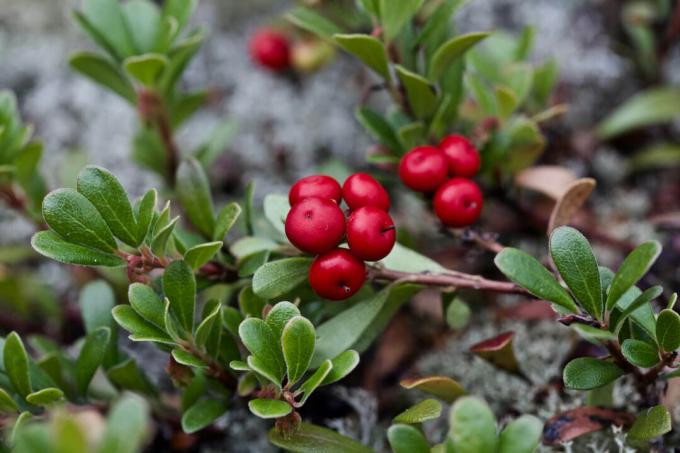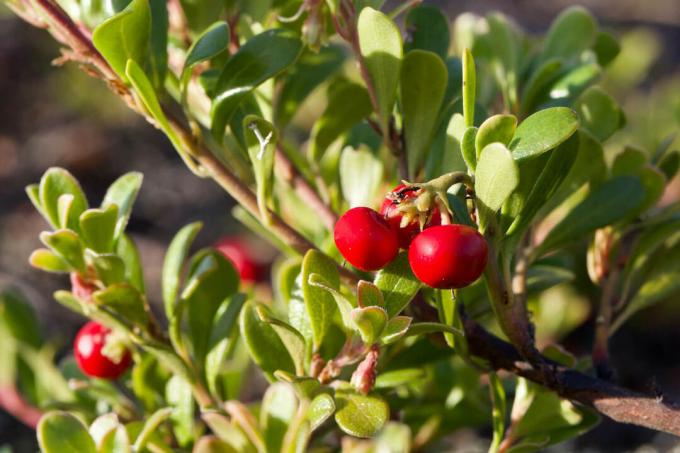The bearberry has become rare in Germany and is strictly protected. To use the leaves for medicinal purposes, you can plant them in your own garden.

Their evergreen leaves embellish the garden all year round and are sometimes supported by pretty flowers and berries. The bearberry (Arctostaphylos uva-ursi) of great value as a forage crop. Here we show how to plant, care for and use the undemanding plant.
contents
- Bearberry: origin and characteristics
- Planting and maintaining
-
Harvest, effects and uses of the bearberry
- Bearberry Leaves
- Fruits of the berry grape
- Is bearberry poisonous or edible?
Bearberry: origin and characteristics
The real bearberry (Arctostaphylos uva-ursi) or evergreen bearberry is common in the northern hemisphere and belongs to the heather family (Ericaceae). It grows as a dwarf shrub and reaches heights of up to 50 cm, but usually remains somewhat smaller at around 25 cm. The perennial plant can live up to 120 years in good conditions, but it grows very slowly. They are more likely to be found in the mountains in the south, and also in lower areas in the north. Several specimens together can form carpets or mats that cover the entire floor.
The bearberry leaves are egg-shaped, leathery and coarse and, depending on their age, smooth or hairy. On the surface they are shiny green, underneath you can see leaf veins arranged like a network. The shoots of the leaves can be more or less hairy. From March onwards, bell-shaped flowers are formed, which are arranged in clusters and are white to bright pink-red in color. In August, the spherical stone fruits appear, which shine red and look like berries. The roots of the bearberry reach a meter deep and are therefore helpful for the water supply.
Bearberries that grow naturally are considered endangered and are therefore protected by law. Further names for them are urea, sandberry or cranberry, although they are not of the species group Cranberries listened to.

Tip: Bearberry contains tannins that are found in many medicinal plants. The content of bearberry is so high that the leaves were used to tan leather in the past.
Planting and maintaining
Like the related one Peat myrtle (Gaultheria mucronata) as Bell heather (Erica tetralix) and cranberry (Vaccinium vitis-idaea), which also belong to the heather family, the bearberry prefers acidic soils. The location should also be sunny to slightly shady and dry to fresh, the substrate should be permeable and rather poor in nutrients. To meet the requirements of the bearberry, mix an acidic substrate such as ours Plantura Bio-Acid Soil in the ground. It is specially formulated for plant species that need an acidic environment in order to grow well. If the garden soil is very clayey, i.e. heavy, then sand must also be mixed in for better permeability. You can plant the bearberry all year round. As a rule, spring is best, as the plant then has time to grow vigorously until winter. For sowing, however, autumn is recommended, as the bearberry is a Cold germ is. A distance of about 40 cm between the bearberries should be kept.
Tip: Due to the flat growth and mat formation, bearberries are often used as ground cover. Two to three plants per square meter are sufficient for this.
The bearberry is very undemanding in terms of care. After planting and in the pot, it should be watered occasionally. Larger specimens grown in the garden usually do not need additional water.
Bearberry hardly needs even regular fertilization. In the case of potted plants, it is sufficient to use a little acidifying fertilizer like ours in autumn or when repotting Plantura organic hydrangea fertilizer work into the soil. It is ideal for bog plants and their soils and contains all the important nutrients.
The low growth of the plant makes it unnecessary to cut the bearberry. If there are annoying, old or dead branches, they can be removed without any problems.

Harvest, effects and uses of the bearberry
Bearberry leaves have been used in medicine for a long time and the berries are also edible. Above all, the substance arbutin it contains is responsible for the plant's antiseptic properties. Bearberry leaves help with bladder infections and urinary tract infections. The arbutin is converted into hydroquinone in the body, which inhibits the growth of bacteria. Since the substance is excreted via the kidneys, the urinary tract is basically slightly disinfected.
Bearberry Leaves
In medicine, only the leaves of the bearberry are used because they contain the active ingredients. They can be harvested from the evergreen plant all year round. It is better to harvest young leaves as they contain less tannin. A bearberry leaf tea, for example, helps against cystitis. The bearberry leaves unfold their effect best through a cold extraction. To do this, let the dried leaves soak in cold water overnight. A hot infusion also works, but tastes bitter and releases more tannins that can irritate the stomach. Bearberry leaf tea should not be consumed for more than a week in a row and a total of five weeks a year, as the dosage is too high.

Tip: The antiseptic effect of the bearberry leaves is stronger in alkaline urine than in acidic urine. For more alkaline urine, a lot of fruit and vegetables and few animal products should be consumed.
Fruits of the berry grape
The bearberry fruits are not used medicinally, but are edible. They taste slightly bitter and have a floury consistency. Since they taste sweeter after cooking, you can make delicious jellies and jams by adding sugar. The red fruits of the bearberry are harvested between September and October.
Is bearberry poisonous or edible?
The bearberry is not poisonous. However, if consumed in excess, stomach problems can occur. To be on the safe side, bearberry leaves are not recommended during pregnancy, breastfeeding or for children. The same applies to pets: the bearberry is edible and only problematic in large quantities.

Everything important too Origin, cultivation and use of the blueberry learn from our related article.

